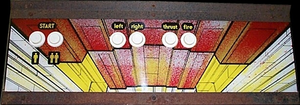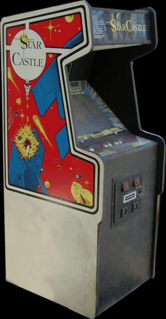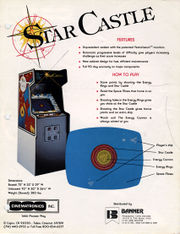Lost In Translation/Star Castle
| Star Castle | |
|---|---|
| Manufacturer | Cinematronics |
| Released | 1980 |
| Control Method |
2-way Joystick 2 Button(s) |
| Main CPU | CCPU (@ 5.000 MHz) |
| Sound CPU | Mono Discrete |
| Video Details |
Vector (Horizontal) 0 x 0 pixels 38.00 Hz 32,768 Palette colours |
| Screens | 1 |
| ROM Info | 10 ROMs 8,608 bytes (8.41 KiB) |
| MAME ID | starcas · spaceftr · starcas1 · starcase · starcasp · stellcas |
About The Game
Star Castle is an arcade video game shoot-em-up.
A 1- or 2-player outer space action game designed with features geared for maximum player appeal : A progressively difficult competitive level and a clearly defined enemy which must be both attacked and avoided at various points in the course of play.
The centre of the play-field is occupied by the Star Castle which is programmed to constantly home in on the players' ships. Surrounding the Star Castle are three concentric energy rings of twelve segments each, which serve as both a protective perimeter for the Star Castle and a source of points for the player. Contained within the energy rings are three protective mines which seek out the players' ships and destroy them upon collision. The movements of the mines are programmed to simulate the actions of heat-seeking missiles.
The object of the games of Star Castle is to score the maximum number of points possible. This is accomplished by the combination of three elements :
- Exploding the ring segments.
- Exploding the Star Castle.
- Avoiding the Star Castle's mines. A player's turn is over when his ship has been destroyed. The number of ships per game is set by the operator.
For maximum scoring, a player will want to shoot out sections of the energy rings in order to give him a shot at the Star Castle in the centre of the screen. As play progresses, there are 2 facts a player must keep in mind :
- Exploding all segments in a given ring will cause the entire ring to reappear - thereby eliminating a potential shot at the Star Castle in the centre.
- Exploding the rings in a manner that gives you a shot at the Star Castle will also give the Star Castle a shot at you. The Star Castle is programmed so that its nose always seeks out the player's ship. If there is an open shot at the player, it will take it.
When the Star Castle is hit by a player's missile, it will first implode and then explode with all remaining ring segments. After a one-second delay, the Star Castle will reappear with all three ring segments. If the Star Castle shoots the player, his turn is over.
As play begins, the Star Castle will appear in the centre of the screen surrounded by its 3 energy rings. The player's ship appears about halfway up on the right hand edge. By using the control buttons to move forward, right or left, the player manoeuvres about the screen using the firing button to launch missiles.
Points are scored by destroying the energy ring segments or the Star Castle itself. Exploding the Star Castle gives an extra ship as well as points. No points are given for the mines that attack the player.
The player's ship can be destroyed in 2 ways : By collision with the mines or by a hit from the Star Castle's torpedo. The mines are launched from the rings and attack the player for approximately ten seconds or until shot. The Star Castle's torpedoes are launched only when there is a clear shot at the player through all 3 rings. At this time the player also has his shot at the Star Castle. Both the Star Castle and the mines get smarter and faster as the game progresses.
The game of STAR CASTLE is not based on time units. The battle rages on until all the players' ships are destroyed. The length of the game depends solely on the skill of the player. It's the age-old challenge of man versus machine.
Additional Technical Information
Players : 2
Buttons : 4 (Left, Right, Thrust, Fire)
Trivia
Released in September 1980.
This was one of the first games to use an experimental artificial intelligence to harass the game player's ship. The star constellation in the background was actually the outline of a centrefold from a 1980 issue of OUI magazine. When management found out after shipping about 5,000 units, they flipped out and almost stopped production. They eventually came to their senses and nothing was changed.
About 14,000 units were produced.
The original inspiration for the game reportedly came from an early version of Larry Rosenthal's never-released "Oops!" in which the player controlled a sperm trying to fertilize an egg in the centre of the screen. Later, Dan Sunday changed the game so that the player rotated in the middle of the screen, protected by rotating blocks, and shot snowflake-shaped objects that were flying towards him. Eventually, the player would be overwhelmed by the objects and the game would be over. Tim Skelly later changed the game around to its final form by anchoring the enemy in the middle of the screen, and having the player fly around and destroy the shield to get to the enemy.
Licensed to Mottoeis for Spanish manufacture and distribution.
A bootleg of this game is known as "Stellar Castle".
A Star Castle unit appears in the 1982 movie 'Fast Times at Ridgemont High', in the 1982 movie 'Rocky III', in the 1983 movie 'Joysticks', in the 1986 movie 'Maximum Overdrive' and in the 1996 movie 'High School High'.
A Star Castle cabinet can be seen in the background of the 1984 movie Ghostbusters (in the scene when they're eating and suddenly they get a call to their first case at the Sedgewick Hotel).
A Star Castle unit appears (multiple times) in a 'Columbo' episode : (Murder, Smoke and Shadows) directed by James Frawley (in the same episode you can see beside this cabinet a "Joust" unit).
The Atari 2600 game "Yar's Revenge" originated from a rough version of Star Castle for that system which never made it to production.
Scoring
| Ring | Points |
|---|---|
| Outer | 10 |
| Middle | 20 |
| Inner | 30 |
There are a total of 720 points possible for each set of three rings.
When you destroy the laser cannon, you get the points for rings remaining plus points for destroying the cannon plus an extra man as a bonus for destroying the cannon.
Sparks are worth no points.
Tips and tricks
- Get used to using the edges of the screen. it will come in handy once you start using the patterns set forth below, and it's always a good habit in ASTEROIDS-type games.
- After a certain point in the game, you must learn never to stay in one place for more than a second.
- It's a shame that the game speeds up with time instead of with each cannon destroyed otherwise, you could play indefinitely simply by destroying the first castle's outer ring over and over. As it is, though, you must take as little time as possible to destroy each castle, ensuring a steady supply of bonus ships.
- Except for shifting the slow ring to the middle later in the game (see Strategy I)) try not to let a castle grow new rings, it wastes time.
- Similarly, shoot an approaching bomb only if it is alone and you do not wont to move. Otherwise, you are wasting your time, gaining no points, and taking the risk of missing.
- When you have only the inner ring between you and the cannon and you are close enough, a triple burst will destroy it before it has a chance to retaliate.
- When the game begins to speed up, try this simple pattern : go to the centre of the left or right edge and face the edge of the screen. Your shots will cross behind and hit the other side of the castle. As soon as the bombs get too close for comfort, simply thrust about an inch forward and you will be on the other side of the screen, still firing at the castle. As the bombs cross the screen towards you, turn around and repeat the procedure.
- Once the game is at maximum speed, you will need a more sophisticated technique. Here it is : Spend all your time in 2 opposite corners. You should dart back and forth behind the screen developing a turn-thrust-shoot rhythm and synchronizing it with the outer ring so that you are always shooting at the same spot. Once you perfect this method, the cannon and bombs will never be fast enough to do more than almost destroy you.
- For best effect, the corner pattern should be followed with the slow ring in the middle. You can shift it to this position by quickly destroying the outer wall twice before beginning your attack in earnest.
Staff
- Designed By
- Tim Skelly
- From An Early Demo By
- Dan Sunday
- Programmed By
- Scott Boden
Cabinet and Artwork
Ports
- Consoles
- GCE Vectrex (1983)
- Others
- Tiger LCD Handheld Game (1982)
- Tiger LCD Tabletop Game (19??)







